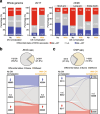Copy number normalization distinguishes differential signals driven by copy number differences in ATAC-seq and ChIP-seq
- PMID: 40155863
- PMCID: PMC11951689
- DOI: 10.1186/s12864-025-11442-y
Copy number normalization distinguishes differential signals driven by copy number differences in ATAC-seq and ChIP-seq
Abstract
A common objective across ATAC-seq and ChIP-seq analyses is to identify differential signals across contrasted conditions. However, in differential analyses, the impact of copy number variation is often overlooked. Here, we demonstrated copy number differences among samples could drive, if not dominate, differential signals. To address this, we propose a pipeline featuring copy number normalization. By comparing the averaged signal per gene copy, it effectively segregates differential signals driven by copy number from other factors. Further applying it to Down syndrome unveiled distinct dosage-dependent and -independent changes on chromosome 21. Thus, we recommend copy number normalization as a general approach.
Keywords: ATAC-seq; Aneuploidy; ChIP-seq; Copy number normalization; Copy number variation; Differential analysis; Dosage effects; Down syndrome.
© 2025. The Author(s).
Conflict of interest statement
Declarations. Ethics approval and consent to participate: Not applicable. Competing interests: The authors declare no competing interests.
Figures





Similar articles
-
CoBRA: Containerized Bioinformatics Workflow for Reproducible ChIP/ATAC-seq Analysis.Genomics Proteomics Bioinformatics. 2021 Aug;19(4):652-661. doi: 10.1016/j.gpb.2020.11.007. Epub 2021 Jul 18. Genomics Proteomics Bioinformatics. 2021. PMID: 34284136 Free PMC article.
-
ATAC-seq normalization method can significantly affect differential accessibility analysis and interpretation.Epigenetics Chromatin. 2020 Apr 22;13(1):22. doi: 10.1186/s13072-020-00342-y. Epigenetics Chromatin. 2020. PMID: 32321567 Free PMC article.
-
Comparison of differential accessibility analysis strategies for ATAC-seq data.Sci Rep. 2020 Jun 23;10(1):10150. doi: 10.1038/s41598-020-66998-4. Sci Rep. 2020. PMID: 32576878 Free PMC article.
-
Bibliometric review of ATAC-Seq and its application in gene expression.Brief Bioinform. 2022 May 13;23(3):bbac061. doi: 10.1093/bib/bbac061. Brief Bioinform. 2022. PMID: 35255493 Free PMC article. Review.
-
Interrogating the Accessible Chromatin Landscape of Eukaryote Genomes Using ATAC-seq.Methods Mol Biol. 2021;2243:183-226. doi: 10.1007/978-1-0716-1103-6_10. Methods Mol Biol. 2021. PMID: 33606259 Review.
References
-
- Klemm SL, Shipony Z, Greenleaf WJ. Chromatin accessibility and the regulatory epigenome. Nat Rev Genet. 2019;20:207–20. - PubMed
MeSH terms
LinkOut - more resources
Full Text Sources

